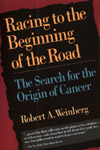Racing to the Beginning of the Road: The Search for the Origin of Cancer
encontrar mi
Author: Robert A. Weinberg |
This book covers cancer research beginning in the mid-1970's, and ending in 1986. The author, Robert A. Weinberg, is a founding member of the Whitehead Institute for Biomedical Research and a professor of Biology at the Massachusetts Institute of Technology. He feels that huge advances were made in understanding cancer and its causes during that decade.
Weinberg supplies multiple reasons for penning this work. The first is the fascinating advances that have been made in cancer research, another is his belief that since the public funds this research, they are entitled to know what their money supports. A final reason is his idea that cancer research attracts many different personalities, and thus makes for many interesting and often humorous stories. In Weinberg's own words: ". . .I wanted to tell a tale that was engaging and accessible to the nonscientific reader. . ."
The book has 268 pages. Although it is very easy to read for someone without a scientific background, it is quite interesting for a scientist as well. It chronicles the history of cancer research, beginning with Warburg's 1955 mistaken belief that he had uncovered the origin of cancer (". . .cancer cells can live without oxygen. . ."). It goes on to tell of great advances, such as Yamagiwa's success as the first to grow cancerous tumors in rabbits, making research easier. Advances in viral genetics, the discovery of reverse transcriptase, and the design of the DNA hybridization technique are next. The road to the origin of cancer has many detours, such as the false belief in human cancer viruses, with the government spending millions of dollars on "The Special Virus Cancer Program" that turned up nothing. The book culminates with the eventual discovery of a proto-oncogene, onco-genes, and tumor suppressor genes.
The history is fascinating, but it is the author's style that makes this a pleasure to read. It reads like a novel, with heroes such as Warburg and Yamagiwa embroiled in a war against the enemy, cancer. Weinberg does not just describe people's research, but their personalities and quirks as well. A certain Dr. Spiegelman, for example, keeps a picture of a turtle on his office wall, explaining that "Exciting, cutting-edge science was not for those who were afraid of getting their heads chopped off." Two researchers, Salk and Sabin, had ". . .a deep, unrelenting, mutual detestation. . ." A young graduate student, Mark Spector, is referred to as ". . .some smartass kid from the East."
You can really feel the author's excitement and energy. For example, he writes that a lecture given by a Greek virologist named Spandidos was ". . .nothing short of stunning." Recalling a gene transfer experiment he himself performed, he states "I made the subtle move from being an enthusiast to being a believer." The frustration of cancer research is compared to ". . .Moses. . .allowed to view the Promised Land from afar but was prevented from entering it. . ."
This book is educational and entertaining, factual and fun. It is worth reading for anyone with an interest in the history of cancer research, whether they have some scientific knowledge or not. Weinberg makes cancer research history interesting, calling it "The play of many acts. . ."
The OncoLink editorial team highly recommends this book.


